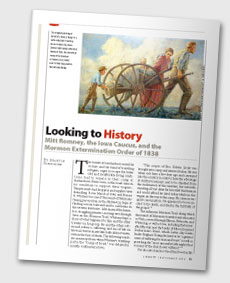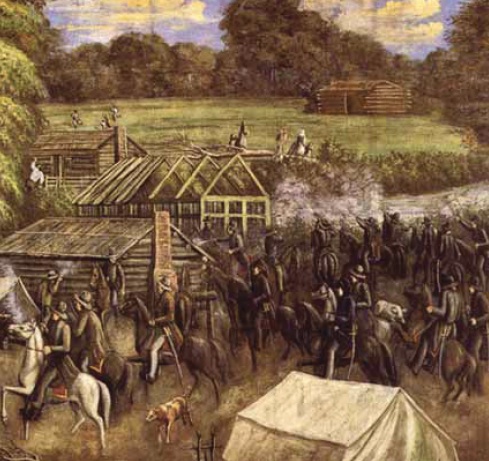Looking to History
Martin Surridge July/August 2012
The torrent of rain had not ceased for 10 days and the band of traveling refugees, eager to escape the bitter cold and insufferable living conditions, had to remain in their camp at Richardson's Point, Iowa, as the roads were in no condition to support their wagons. Temperatures had dropped, and supplies were dwindling. It was March of 1846, and Horace K. Whitney was one of thousands of Mormons fleeing persecution in the Midwest in hope of finding a more tolerant land to call home in the western territories. Like many of the homeless, struggling pioneers, moving west through Iowa on the Mormon Trail, Whitney kept a diary of what happened to him and the other travelers in his group. He and the others witnessed sickness, suffering, and loss of life on the trail, but for many their faith did not waver, even in the face of death. The following words are an excerpt from when Whitney's traveling party, the "Camp of Israel," was delayed in muddy, southeastern Iowa.
"The corpse of Bro. Edwin Little was brought into camp and interred today. He was taken sick here a few days ago and conveyed into the country in order to have the advantage of skillful treatment and to be shielded from the inclemency of the weather; but notwithstanding all was done for his relief that human aid could afford he died today while in the wagon on the way to the camp. His disease was quick consumption. He appeared to be reconciled to his death, and died in the full faith of the gospel."1
The infamous Mormon Trail, along which thousands of Mormons traveled and relocated to Utah, crossed through Illinois, Nebraska, and Wyoming, as well as Iowa, including that miserable little stop near the border of Missouri named Richardson's Point, which Latter-day Saints leader Brigham Young declared to be "a general scene of suffering for man and beast" as well as providing the "most uncomfortable nights that so many of the church ever suffered."2
For decades America's heartland was hardly a welcome place for members of the Church of Jesus Christ of the Latter-day Saints (LDS), and the difficulties experienced by Mormons in Iowa and Missouri are hardly confined to the history books either. In November of last year the Des Moines Register posted an online piece focusing on the discrimination that many Mormons in Iowa had suffered throughout their working lives. The newspaper interviewed members of the Church of Jesus Christ of Latter-day Saints in Iowa, such as Drake University psychology professor Steve Faux, who declared that he "never felt self-conscious about [his] religion until [he] lived in Iowa," and Robert Nye of Urbandale, Iowa, a Mormon and an employee of Wells Fargo, who recalled an incident in which a recruiter refused to hire an LDS colleague because of his faith.3 These contemporary, intolerant attitudes would hardly be surprising to the "Camp of Israel" travelers 166 years ago—in fact, for them, they would actually represent a vast improvement for Mormon living conditions in the Midwest. However, the development of America's political landscape, especially in Iowa, would have probably shocked and amazed them. Presidential candidate Mitt Romney campaigning in West Des Monies, Iowa.
Presidential candidate Mitt Romney campaigning in West Des Monies, Iowa.
Fast forward to the beginning of this year when one political story was on the front page of every daily newspaper in the country. The 2012 Republican primaries began in January, with the Iowa caucus kick-starting what would be a very long election season. The name of one candidate in particular, a front-runner in many circles, seemed to be on the lips of most conservatives, albeit perhaps begrudgingly so. Mitt Romney, a moderate Republican former governor of Massachusetts and a Mormon businessman from a successful family, had failed to gather enough support from hard-line conservatives in Iowa to win the caucus convincingly, yet still managed a narrow victory over former Pennsylvania senator Rick Santorum. Although the news media and election officials later announced that after recounting the ballots it was technically Santorum who had won the caucus, Romney had, by that point, already won the New Hampshire primary, in large part because of the momentum he had received after "winning" in Iowa.
How fascinating it would be to see the reactions on the faces of Horace K. Whitney, Brigham Young, and the other Mormon travelers, if they were to be told that one day, not too far from the very spot where they camped in Van Buren County, thousands of conservative voters would gather in school gymnasiums and civic auditoriums to put forth their support for the first Mormon president. In recent history success in Iowa has proved decisive in capturing the presidential nomination for both of the major political parties in the United States. Past winners of the Iowa caucus include Republicans George W. Bush in 2000 and Bob Dole in 1996, and Democrats Al Gore in 2000, John Kerry in 2004, and Barack Obama three and a half years ago.
November 2008 was truly a watershed moment in African-American history, as well as for the world in general. A candidate from a historically persecuted minority proved skeptics wrong, overcame what many thought was an impassable barrier, and was chosen by the people of the United States to become the first American president from such a politically marginalized group. Barack Obama was at the center of this story in 2008, but if the election had taken a different turn, similar sentiments could have been uttered about Hillary Clinton as the first woman president. Now, during this election season, Romney is another groundbreaking contender, the candidate who could become the first president from the Church of Jesus Christ of Latter-day Saints.
Some might argue that to compare the historical persecution of Mormons to the systematic abuse suffered by African-Americans since the creation of the country is insensitive or inaccurate. Or that American women have suffered longer and in greater numbers across the country. These points are indeed valid. However, the history of persecution of the Mormon Church is unique in American history in that it is the only religious group of Western origins to be the target of a state-sanctioned military campaign ordering its removal and threatening any resisters with death.
The aforementioned Van Buren County in Iowa shares a border with the state of Missouri, the state in which on October 27, 1838, Governor Lilburn Boggs signed one of the most infamous executive orders in American religious history. Nicknamed the "Mormon Extermination Order," Missouri Executive Order 44 stated that "Mormons must be treated as enemies, and must be exterminated or driven from the state if necessary." What ended with the expulsion of about 8,000 Mormons from the state of Missouri began with fear-mongering and misrepresented beliefs.
Uneasy that Latter-day Saints founder Joseph Smith had designated western Missouri as the location for "where 'Zion' would be 'gathered' in anticipation of Christ's second coming,"4 frontier settlers from other faith traditions "characterized the Mormon settlers as fanatics whose clannish behavior made a mockery of republican institutions by placing power in the hands of a single man."5 Skirmishes broke out when other settlers attempted to subdue and control the ever-booming LDS population. It became increasingly difficult for the Mormon paramilitary groups to tell the difference between armed, angry mobs and companies of state militiamen, and the fighting escalated into what was soon called the 1838 Mormon War or the Missouri-Mormon War.
In his executive order Governor Boggs, as commander in chief of the state militia, gave General John B. Clark of the Missouri state forces the following instructions:
"Cause 400 mounted men to be raised within your division, I have received . . . information of the most appalling character, which entirely changes the face of things and places the Mormons in the attitude of an open and avowed defiance of the laws and of having made war upon the people of this state. Your orders are therefore to hasten your operation with all possible speed. The Mormons must be treated as enemies and must be exterminated or driven from the state if necessary for the public peace—their outrages are beyond all description. If you can increase your force, you are authorized to do so to any extent you may consider necessary."6
 Painting depicting the Haun's Mill Massacre,
Painting depicting the Haun's Mill Massacre,
during which a mob killed seventeen men, women, and children.
After the state militia and Mormon forces clashed at the Battle of Crooked River, a victory for Mormon forces, where three Mormons and one militiaman died, the violence in Missouri only became worse. The Missouri State Archives explain how "the conflict's viciousness escalated, however, even without official sanction, when, on October 30, 1838, an organized mob launched a surprise attack on the small Mormon community of Haun's Mill, massacring 18 unsuspecting men and boys" at work on their farms and in their barns.7 In addition, one non-Mormon ally was killed, and 13 others were wounded, including a woman and a 7-year-old boy.
The massacre at Haun's Mill, in the heavily Mormon district of Caldwell County, was the bloodiest day of the Missouri-Mormon War, despite no fatalities suffered by the Missourian mob. The particularly barbaric nature of the murders remains in the collective memory of the Mormon community today. Among those who were killed was "78-year-old Thomas McBride [who] surrendered his musket to militiaman Jacob Rogers, who shot him, then hacked his body with a corn knife," and another militiaman, "William Reynolds, discovered 10-year-old Sardius Smith hiding under the bellows and blew the top of the child's head off."8 Witnesses said that "the dead were thrown into an unfinished well and lightly covered with dirt and straw. A few Missourians returned the next day, took plunder, and warned the remaining saints to leave Missouri."9
After this tragic incident thousands of Mormon families surrendered their property and left for Illinois, where it would only be a matter of time before hostility in the Prairie State—including the murder of Latter-day Saints founder Joseph Smith and his brother Hyrum by a mob in Carthage, Illinois, in June of 1844—forced them on their western exodus through Iowa and eventually all the way to Utah.
Executive Order 44 was formally rescinded in June of 1976 by Governor Christopher Bond, "noting its legal invalidity and formally apologizing on behalf of the state of Missouri for the suffering it had caused the Latter-day Saints."10 While it may have been repealed, the extermination order has not been forgotten. LDS churches include it in their Sunday school curriculum, telling the stories of Haun's Mill and Governor Boggs to Mormon youth like Jeffrey White, who is now a high school French and social studies teacher in Grandview, Washington. White, like many voters in America, is still deciding whom to support in this year's contest for the presidency, and he discussed whether Romney's faith would play a part in his decision, should Romney be the eventual nominee.
"Would I consider voting for Mitt Romney simply because he is Mormon?" he wonders out loud. "It would be a milestone, but there are many Mormons that I would want nowhere near the White House. The fact that he is Mormon does not help him, nor does it hurt him from my view."
"I am happy to live in a country where religious groups are protected by law from being harmed physically or financially," White exclaimed. "But I realize that there are many groups, not only my own, who receive social harm on a regular basis with little outcry."
If Mitt Romney were to become the first president of the United States from the Church of Jesus Christ of the Latter-day Saints, it would indeed be a milestone given the history of Mormonism in America, especially when one considers that for a while Latter-day Saints were public enemy number one in many of the same Midwestern states that nominated Romney ahead of Santorum and former House speaker Newt Gingrich.
"You shouldn't elect a president on the basis of milestones any more than you should make your choice based on professed faiths," said White, whose membership in the Mormon Church has resulted in lost job opportunities and the mockery of many colleagues and classmates. The history of Mormon persecution has been well documented in America, and White remains optimistic and thankful for the religious liberty he and his family enjoy today. Although religious persecution and prejudice rarely disappear completely, new targets are often chosen, and future historians may look back on our era with the same sadness we experience when examining nineteenth-century Iowa and Missouri.
1 Journal of Horace K. Whitney, Mar.18, 1846; available online at http://www.lds.org/gospellibrary/pioneer/05_Richardsons_Point.html.
2 Brigham Young, as quoted in Wallace Stegner, The Gathering of Zion: The Story of the Mormon Trail; quotes available online at www.lds.org/gospellibrary/pioneerlds_Richardsons.Point.html.
3 Daniel Finney, "Politics Shines Light on Old Prejudices About Mormons," Des Moines Register, Nov. 26, 2011; available online at http://caucuses.desmoinesregister.com/2011/11/26/politics-shines-light-on-old-prejudices-about-mormons/.
4 Missouri State Archives, "The Missouri Mormon War,"www.sos.mo.gov/archives/resources/mormon.asp.
5 Ibid.
6 Ibid.
7 Ibid.
8 "Haun's Mill Massacre," Encyclopedia of Mormonism; available online at http://eom.byu.edu/index.php/Haun%27s_Mill_Massacre.
9 Ibid.
10 www.lds.org/gospellibrary/pioneer/02_Nauvoo.html.
Article Author: Martin Surridge
Martin Surridge has a background in teaching English. He is an associate editor of ReligiousLiberty.TV, an independent news Web site. He writes from Calhoun, Georgia.